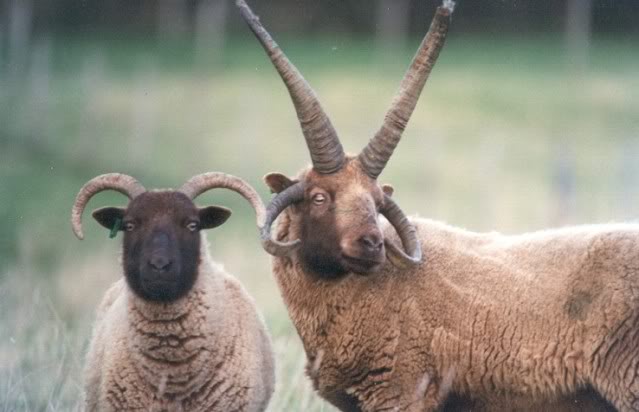COUNTING SHEEP
In addition to inducing somnolence, sheep are counted by shepherds to audit their flocks. Traditionally, special counting terms were used which varied across Britain and within regions. Below is one of the many (now archaic) versions:
1....................Yan
2....................Tan
3..................Tether
4.................Mether
5.....................Pit
6..................Tayter
7..................Layter
8..................Overa
9.................Covera
10..................Dicks
11............Yan-a-Dicks
12............Tan-a-Dicks
13.........Tether-a-Dicks
14........Mether-a-Dicks
15................Bumfit
16..........Yan-a-Bumfit
17..........Tan-a-Bumfit
18........Tether-a-Bumfit
19.......Mether-a-Bumfit
20..................Jiggit
20 sheep are a "score"

Isle of Man Sheep
Other thoughts on this, and other lists:
THE SHEEP-COUNTING SCORE
By WALTER SKEAT, 1910
http://www.isle-of-man.com/manxnotebook/fulltext/sheep.htm
I will now take as an example one of the new sets of the score, which still "holds" with some of the old shepherds of Lincolnshire

Lincolnshire Sheep
1. Yan.
2. Tan.
3. Tethera.
4. Pethera.
5. Pimp.
6. Sethera.
7. Lethera.
8. Hovera.
9. Covera.
10. Dik.
11. Yan-a-dik.
12. Tan-a-dik.
13. Tethera-dik.
14. Pethera-dik.
15. Bumpit.
16. Yan-a-bumpit.
17. Tan-a-bumpit.
18. Tethera-bumpit.
19. Pethera-bumpit.
20. Figgit (sic, ?Jiggit).
Now this is Sandra again. I've heard often that "eeny, meenie, miney, mo" is from some forgotten counting system of ancient days. Why not? Makes sense.
But reading at the link above, there was mention of those numbers being used also by older women to count their rows of knitting and to amuse children. Because of that I propose an idea (and if anyone knows of documentation that I'm right, woohoo!): I think the "counting sheep" tradition is probably from this, and further I'm going to venture to guess that there was a tune or chanting rhythm that went with that counting and that parents or grandparents "counted sheep" until a child fell asleep, like a lullaby, and that children could do it too.
Counting sheep with regular numbers seems goofy, and few people know much about sheep anyway. But in sheep-raising areas, with traditional counting schemes, starting over every time you get to 20, it could be very lulling and comforting (and boring, and possibly musical).
As to "score," it's known that there were accounting sticks, "tally sticks," and I'm figuring "score" was to make a mark (representing 20) with a knife, or a rock on a stick, or another stick on the stick.... a literal score: a shallow cut.
No doubt a score or more of anthro- archeo- and historologists have all thought of these things, but it was fun to think of them myself, based on the randomish trivia I ordered up and the hundred-year-old account I googled up to go with it.
Tally stick images, some fancy ones and some plainer ones (photos are links):
And simple everyday tally sticks used to be marked like this sometimes:

Gold Exchange
Here's one for noting gold exchange:

The marks were made on a whole stick, and then the stick was split so each in the transaction had a copy.
Cricket Scores
No image, but an article here is about cricket scores being kept on tally sticks in the late 19th century.
Sheep-counting sticks

"In the Lake district the shepherds may still be heard counting sheep with the following words, some of which are like Welsh numbers: "Yan, Tan, Tethera, Methera, Pimp, Sethera, Lehtera, Hovera, Dovera, Dick, Yan-a-Dik, Tan-a-Dick, Tethera-a-Dick, Methera-a-Dick, Bumfit, Yan-a-Bumfit,Tethera-a-Bumfit, Methera-a-Bumfit, Giggot."
I don't have anything to add to the subject, I just wanted to say, "This is SO cool!"
ReplyDeleteMy younger dd couldn't sleep one night so I read them off to her to see if it helped. It made *me* sleepy! lol
I was reading a very cool book about games yesterday, and the author said that those bars of lines that are stuck at the bottom of a letter or postcard are akin to ancient scoring systems. She mentioned the Ishango Bone from Congo. It was a bone discovered in the 50s, covered with notches. Estimated to be between twenty to twenty-thousand years old, it may have been a type of lunar calendar.
ReplyDelete"Math Games and Activities from Around the World" by Claudia Zaslavsky
Hey! This reminded me of "The Music Man"
ReplyDeleteHere's a YouTube clip of that scene (referenced part is about 3 minutes in...) http://www.youtube.com/watch?v=wGRz4jiRRLk
http://www.youtube.com/watch?v=wGRz4jiRRLk
ReplyDeleteThat's cool, because it involves both/separately a speech (never made) that starts (several times and is interrupted) "Four score..." and counting in "the Indian tongue."
I don't have a source but it would be easy enough to search. This came on the Page a Day calendar:
ReplyDeleteMONEY SLANG
Some costermonger’s money-related backslang current during the 19th century:
FLATCH......................half-penny
YENEP............................penny
OWT-YENEPS...................twopence
ERTH-YENEPS................threepence
ROUF-YENEPS.................fourpence
EVIF OR EVID-YENEPS..........fivepence
EXIS-YENEPS....................sixpence
NEVIS-YENEPS................sevenpence
TEAICH or THEG-YENEPS.....eightpence
ENIN-YENEPS.................ninepence
NET-YENEPS...................tenpence
NEVELÉ-YENEPS.............elevenpence
EVLÉNET-YENEPS...........twelvepence
GEN OR GENERALISE.........one shilling
YENEP-FLATCH...........three half pence
OWT-YENEP-FLATCH...................twopence halfpenny
OWT-GENS..................two shillings
ERTH-GENS................three shillings
FLATCH-YENORK............half a crown
YENORK..........................crown
DUNOP..........................pound
Very interesting post. I am studying Austronesian (Indonesian, Polynesian, etc) numbers; see:
ReplyDeletehttp://austronesiancounting.wordpress.com/
and looking into other older number systems as well, which is how I came across your blog.
I'm absolutely sure you're right about 'counting sheep' to send children to sleep, but play with this idea:
Many people now think that these words were brought to England by Welsh sheep drovers in the Middle Ages. They drove their flocks over the open downlands, if possible, but sometimes along main roads when there wasn't any open country. It's a lonely job, shepherding, and perhaps suggests why so many young mothers learned those numbers
I have come back in 2024 to enliven Richard Parker's Link, and also to leave a link to his main page listed from his blogger profile (in archive form, because it's no longer there).
ReplyDeleteaustronesiancounting.wordpress.com
and
coconut studio
The internet is NOT forever. I patch up my own links and sections when I can, but I won't always be able to do so.